38 1980’s: Foreign Entanglements (and “Non-combat” combatants)

“The Atlantic alliance is the core of America’s foreign policy and of America’s own security. Preservation of a peaceful, free, and democratic Europe is essential to the preservation of a peaceful, free, and democratic United States. If our fellow democracies are not secure, we cannot be secure. If you are threatened, we’re threatened. If you’re not at peace, we cannot be at peace. An attack on you is an attack on us. This is not simply a matter of treaty language, important as treaty language is. It is an enduring reality — as enduring as the reality that a threat to the security of the State of Maine or New York or California is a threat to the security of all 50 American States. Simply put: An attack on Munich is the same as an attack on Chicago.” President Ronald Reagan, Address to the Citizens of Western Europe February 23rd, 1988[1]
Child Diplomacy: Samantha Smith – A Thread That Could Have Been Built into a Bridge, 1983-1987
In November of 1983, Samantha Smith, a ten-year-old 4th-grader from Maine, decided to write a letter to the new leader of the Soviet Union, Yuri Andropov. The letter was probably a result of a prompt from her mom as well as a Time magazine: “Jane Smith brought out the November 22, 1982 issue of Time magazine that featured Soviet General Secretary Yuri Andropov on its cover. The new Russian leader had just taken power, and Jane suggested her daughter write him a letter.”[2]
The young Miss Smith wrote:
“My name is Samantha Smith. I am ten years old. Congratulations on your new job. I have been worrying about Russia and the United States getting into a nuclear war. Are you going to vote to have a war or not? If you aren’t please tell me how you are going to help to not have a war. This question you do not have to answer, but I would like to know why you want to conquer the world or at least our country. God made the world for us to live together in peace and not to fight.”[3]
Five months later, the Soviet leader responded, in a much lengthier letter. But he responded. Andropov wrote:
“I received your letter, which is like many others that have reached me recently from your country and from other countries around the world.
It seems to me – I can tell by your letter – that you are a courageous and honest girl, resembling Becky, the friend of Tom Sawyer, in the famous book of your compatriot Mark Twain. This book is well known and loved in our country by all boys and girls.
You write that you are anxious about whether there will be a nuclear war between our two countries. And you ask are we doing anything so that war will not break out. Your question is the most important of those that every thinking man can pose. I will reply to you seriously and honestly.
Yes, Samantha, we in the Soviet Union are trying to do everything so that there will not be war on Earth. This is what every Soviet man wants. This is what the great founder of our state, Vladimir Lenin, taught us.
Soviet people well know what a terrible thing war is. Forty-two years ago Nazi Germany, which strove for supremacy over the whole world, attacked our country, burned and destroyed many thousands of our towns and villages, killed millions of Soviet men, women and children.
In that war, which ended with our victory, we were in an alliance with the United States. Together we fought for the liberation of many people from the Nazi invaders. I hope that you know about this from your history lessons in school. And today we want very much to live in peace, to trade and cooperate with all our neighbours on this earth — with those far away and those near by. And certainly with such a great country as the United States of America.
In America and in our country there are nuclear weapons: terrible weapons that can kill millions of people in an instant. But we do not want them to be ever used. That’s precisely why the Soviet Union solemnly declared throughout the entire world that never — never — will it use nuclear weapons first against any country. In general, we propose to discontinue further production of them and to proceed to the abolition of all the stockpiles on Earth.
It seems to me that this is a sufficient answer to your second question: ‘Why do you want to wage war against the whole world or at least the United States?’ We want nothing of the kind. No one in our country – neither workers, peasants, writers nor doctors, neither grown-ups nor children, nor members of the government – want either a big or a little war.
We want peace. There is something that we are occupied with: growing wheat, building and inventing, writing books and flying into space. We want peace for ourselves and for all peoples of the planet. For our children and for you, Samantha.
I invite you, if your parents will let you, to come to our country, the best time being this summer. You will find out about our country, meet with your contemporaries, visit an international children’s camp called Artek on the sea. And see for yourself that in the Soviet Union, everyone is for peace and friendship among peoples.
Thank you for your letter. I wish you all the best in your young life.”[4]
Notice in the final paragraph Smith was invited to visit the USSR. That will launch not only Smith into the international spotlight but a fervor of activity within the Department of State. Initially, there was some suggestions (never serious discussions) that President Regan accompany Samantha Smith and her parents to the USSR. Reagan vetoed that idea citing long withstanding issues between the US and the USSR that could not be resolved through “publicity ploys.”[5]
However, in the letter sent by Mr. and Mrs. Donald Jelks (private citizens) to President Reagan suggesting that Reagan accompany the Smiths to the Soviet Union, the Jelks referred to Samantha Smith as “the Dove of Peace.” The National Security Council saw the letters, so did the Department of State.[6] While it does not seem that anyone took seriously the suggestions for Reagan to take a backseat to a little girl (she would be the star after all and Reagan had experience not being the top banana), the “Dove of Peace” idea brought up in the Jelks’ letter seems to have stuck as the phrase was used a few times in memos.

Samantha Smith and her parents, Arthur and Jane Smith, tour Red Square in Moscow on July 9, 1983. — The Associated Press
Samantha’s visit went, in a word, well. So much so that the trial balloon was floated to have President Reagan invite Soviet children to visit the US. In July of 1983, Morton Matthew, a constituent of Representative Nancy Johnson sent her a letter suggesting such a program, “is the only cure I can see for the insanity that has engulfed us.”[7]
Johnson forwarded the letter to Reagan, who responded to Johnson in September. “This proposal was recently considered” but was rejected by the Administration due to the belief that doing so would give “a misleading impression towards Soviet policies.” Before supporting a people-to-people program, Reagan wanted to see the Soviets stick to earlier treaty agreements and accords.[8] Of course, Reagan was never a fan of Soviet Union. In the Fall of 1983 he called the communist country “a hostile, predatory empire” occupying directly in Afghanistan and indirectly in parts of Africa.[9]
Smith became a national (international maybe) celebrity. Samantha and her father spent time recording a television show in London. She was on American television shows such as The Tonight Show with Johnny Carson. In 1984, she was on a Disney channel hosting a show for presidential candidates. Regan was invited, but he declined.[10]

On her way home, in the late Summer of 1985, the plane she was on crashed killing everyone on board.
The Cold War continued. For example, the Soviet Union sent weapons and equipment to Cuba, which forwarded them to Nicaragua, which distributed them to Communist guerillas in El Salvador. And so, Reagan sent Americans to the area to help the Salvadoran government to put down the insurgency. The US armed both Iran and Iran in their eight-year-long war. Arms flowed to Iran via Israel to secure the release of American hostages being held in Lebanon by the Iranian-supported Hezbollah. But that’s another story.
Reagan and Andropov did not make nice. Not until Reagan’s famous “Tear Down this Wall” speech in West Berlin (1987) did things really begin to change. Andropov will eventually be replaced by Mikhail Gorbachev. Samantha Smith’s letter never amounts to much except for then-contemporary hope. Such as what Morton Matthew of Litchfield, Connecticut wrote “How tragic if we should lose the thread that could have been built into a bridge.”[11]
This is a work in progress. US foreign policy regarding China, Eastern Europe, and Russia must be added but I wanted to release what we have here now because of President Reagan’s primary concern when he was sworn in as Central America. So, more is forthcoming.
In 1982, upon graduating high school, I tried college. I failed. I lacked the maturity and dedication to succeed. I grew up watching television shows such as The Wild, Wild West, Batman, and the Mod Squad. Shows law enforcement and the positive portrayal of government and working for the government. Ultimately, I wanted to work either for the CIA or the National Security Agency and so I thought about getting some experience in the military. Military Intelligence to be specific. I went to my local recruitment office. I wanted to learn either Polish or Czech and work in Europe, preferably in West Germany. The recruiter said all that was available was Korean, but when I arrived at the language school I should ask the commander if I could change languages. Um, that was an inaccurate piece of advice by the recruiter. So I signed along the dotted line and enlisted in the Army.
“Central America is a region of great importance to the United States. And it is so close: San Salvador is closer to Houston, Texas, than Houston is to Washington, DC. Central America is America. It’s at our doorstep, and it’s become the stage for a bold attempt by the Soviet Union, Cuba, and Nicaragua to install communism by force throughout the hemisphere.” -President Ronald Reagan, 1984[12]
After Basic Training I went to the Defense Language Institute in San Fransisco where I started my Korean studies. Shortly thereafter, a need arose for Spanish linguists and so I volunteered, imagining that I would be assigned to maybe the US Embassy in Spain! The reason for the need for Spanish linguists was that the Cold War was heating up in Central America. Our ally, El Salvador, was inundated with a Nicaraguan-supported, Cuban-backed communist insurgency. Honduras was threatened by the communist country of Nicaragua and Cuba was sending in bigger and better Russian weapons into Nicaragua, which the Reagan administration feared was growing so large Nicaragua could not be stopped from invading its Central American neighbors. There was also a communist insurgency in Guatemala. Remember Guatemala? The US installed a military dictatorship there back in the 1950s. So, there was a great need for Spanish linguists. I did not make it to Spain until a four-hour layover on the way home from Italy in 2007. The Reagan administration began building a US presence in Central America, with the center of the hub being at that time Palmerola Airbase (first renamed the Col Enrique Soto Cano Airbase, then most recently renamed the Comayagua International Airport) just northwest of its capital, Tegucigalpa.
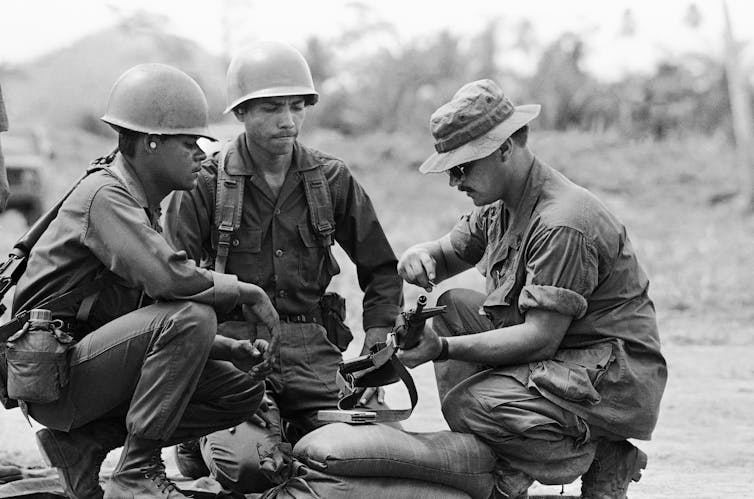
[13]In 1981, President Reagan chose to continue supplying El Salvador’s military with funding that was originally initiated by President Carter’s administration to combat human rights abuses and the threat of communism across Central America.[14] The U.S. funding is significant because El Salvador’s military junta would have fallen apart without U.S. aid due to the socio-economic issues in El Salvador.[15] Since the aid was given as a form of protection against the rise of Communism and Marxism, there were strict conditions requiring reforms and policy changes.[16] One condition of the monetary aid renewal was Congress had to see evidence every two years indicating that the El Salvador government was overall trying to improve human rights.[17] In addition to monetary aid, the U.S. provided the Salvadorian junta with military advisors for “helicopter maintenance” and military training, leased helicopters, and created a counterinsurgency headquarters.[18]
The United States had advisers in El Salvador. Training and working with the Salvadoran military. Sometimes the Salvadoran military went over the cliff, as in the case of Mozote. Americans played some role in the massacre that occurred in El Mozote El Salvador in 1981.[19] The El Mozote massacre was perpetrated during a mission known as “Operation Rescue.”[20]
On December 10th, 1981 members of the El Salvadoran Army, known as the Atlactl Battalion, arrived in the small El Salvadoran village El Mozote.[21] The Atlactl Battalion was a unit that was specially trained for counter-insurgency warfare, also known as a Rapid Deployment Infantry Battalion.[22] The Atlactl Battalion was famous for its brutal and horrendous slaughters of citizens during the El Salvador civil war.[23] El Mozote was a compact village in El Salvador with roughly twenty houses, a church, and one school. The Battalion was on a mission to eliminate the presence of guerrillas in the area.[24] The soldiers of the Atlactl Battalion first separated the men from the women and children. The Battalion tortured the men of the village in an interrogation effort. When the soldiers were finished with that task they executed the men. The Atlactl Battalion next turned their attention, and their machine guns, towards the women of the village. Lastly, the men of the Battalion slaughtered the children. The death count from the village of El Mozote was upwards of seven hundred citizens.[25]
Journalists would bring the massacre to the world’s attention while the Salvadoran government denied it. Evidence was presented to the public by journalists Raymond Bronner and Alma Guillermoprieto, who were the first on the scene after the massacre.[26][27]
The Atlactl Battalion was trained by the United States.[28] The United States also provided the El Salvadoran military with ample financial and material support.[29] The Reagan administration denied the claims of United States involvement in the El Mozote massacre throughout President Reagan’s terms in office.[30] The State Department even asked the U.S. Embassy to investigate the United States’ involvement in the El Mozote massacre with the hope that the U.S. Embassy could refute the claims that the massacre ever occurred.
[31]Experts later testified that U.S. advisor, Sergeant Major Allen Bruce Hazelwood was in the Morazán province with Coronel Domingo Monterrosa, commander of the Atlacatl Battalion during the El Mozote Massacre with personal knowledge prior to the mission.[32]
The results of the U.S. aid ended up taking the lives of around 75,000 Salvadorian civilians, 95% of whom were killed by their military, supported by the U.S.[33] By 1989 75% of Salvadorians lived in poverty and 90% of the population did not have access to clean drinking water.[34] The civil war caused major migration by the citizens of El Salvador to other countries including the U.S.[35] These results are significant because after the United States spent billions on aid for the civil war on the conditions of improving the human rights these numbers should have improved. El Salvador’s economy was destabilized and relied on U.S. aid with assured loss of the limited progress they made if the aid stopped.[36]
[37]There is no doubt that the massacre that happened in El Mozote El Salvador on December 10th, 1981 was a brutal tragedy. The United States helped facilitate this tragedy in a number of ways. The United States trained the Atlactl Battalion. The United States provided both funds and materials to the El Salvadoran military. Had the United States not trained the Battalion, or provided the money to the El Salvadoran military, the little village of El Mozote may not have met such a horrific fate.
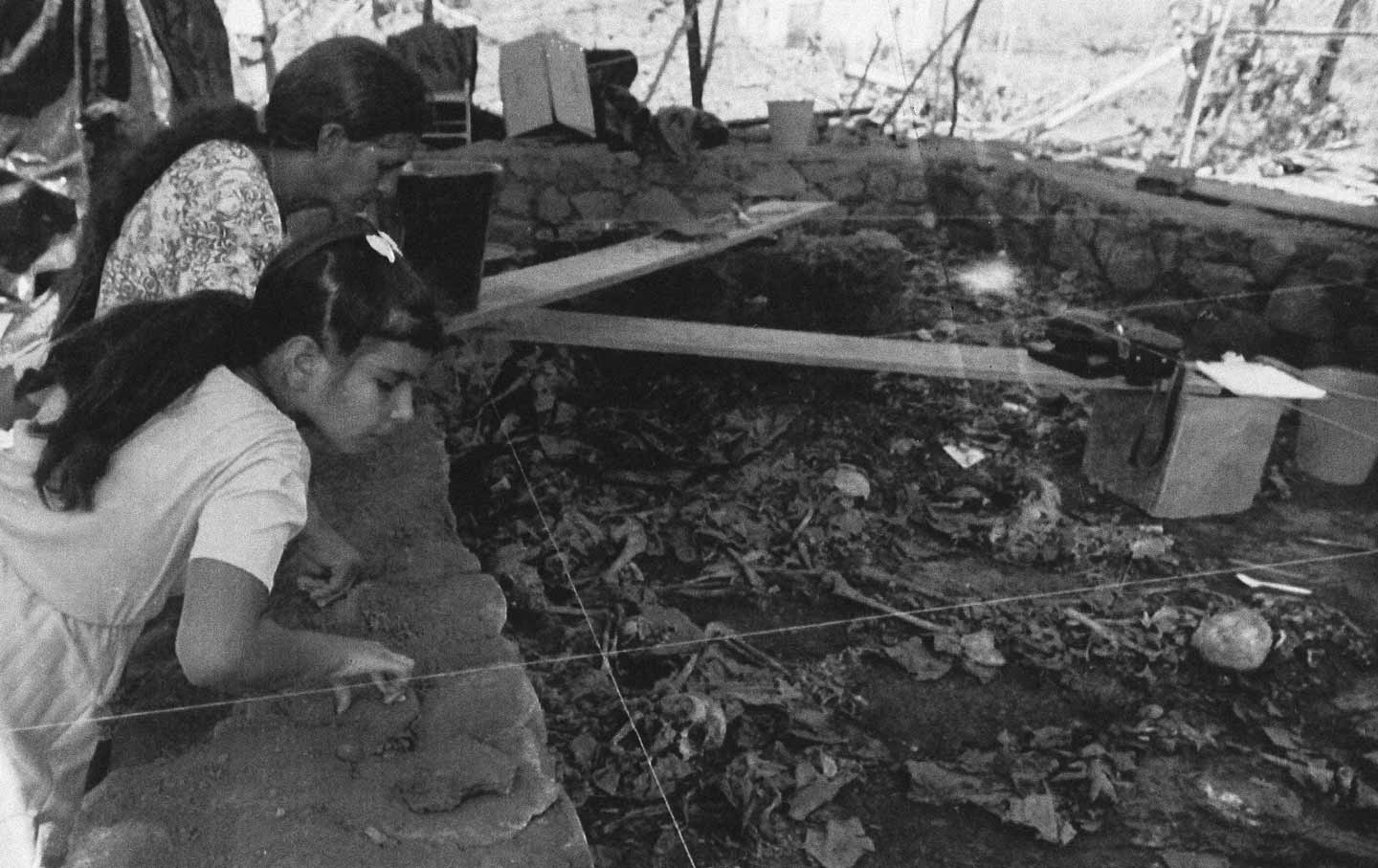
Freedom fighters in Nicaragua and Afghanistan. US advisors in Honduras and El Salvador. Taking part in anti-drug operations such as Operation Blast Furnace in Bolivia. Supplying both sides during the Iran-Iraq War. “Non-combat” roles for US troops in Lebanon and El Salvador (while taking fire). Invading a small island nation in the eastern Caribbean (Grenada) to stop the delivery of Cuban bombers and to save some US medical students? And negotiations with the Russians. Always needed to keep the channels of communication open with the Russians during the Cold War. That was one of the lessons of the Cuban missile crisis of the Kennedy administration. Nuclear weapons got more dangerous due to MIRV: Multiple Independently Targetable Reentry Vehicle. One ballistic missile contains multiple warheads, each capable of having its own target. Think final scene in Dr Strangelove. Then the decade ends with the end of the Cold War and what seems to be a new foreign policy: unplug our Frankenstein’s monsters.
We, the US, wore white hats. The Russians wore black hats. The white hats were the good guys and what they did was for the good of not only the US but for the free world. The US needed supporters and so the US allowed and at times created world leaders who acted in ways that in the long run were antithetical to regional stability (and US domestic considerations -see immigration and the 21st century). But during the Cold War, we supported those who otherwise could be considered evil, brutal dictators such as Saddam Hussein in Iraq, Jose Napolean Duarte in El Salvador, and, Col. Manuel Noriega in Panama. In 1990, President George H.W. Bush sent a contingency of around 28,000 troops to remove Noriega from power in Panama. Hussein followed. Was this a shift in US policy? Was the Bush administration going to remove these dictators that the US needed (and supported, and at times created) during the Cold War? Well, no. There were particular reasons why the US went into Panama and Bush would later say that he did not have the authority to order the capture or killing of Hussein during Operation Desert Storm. But, those stories come later.
At the beginning of the decade, both the US and the USSR had more than enough nuclear weapons to blow each other off the face of the Earth multiple times. So, the counties came together in the 1970s and 1980s to try to negotiate an end to the nuclear arms race.
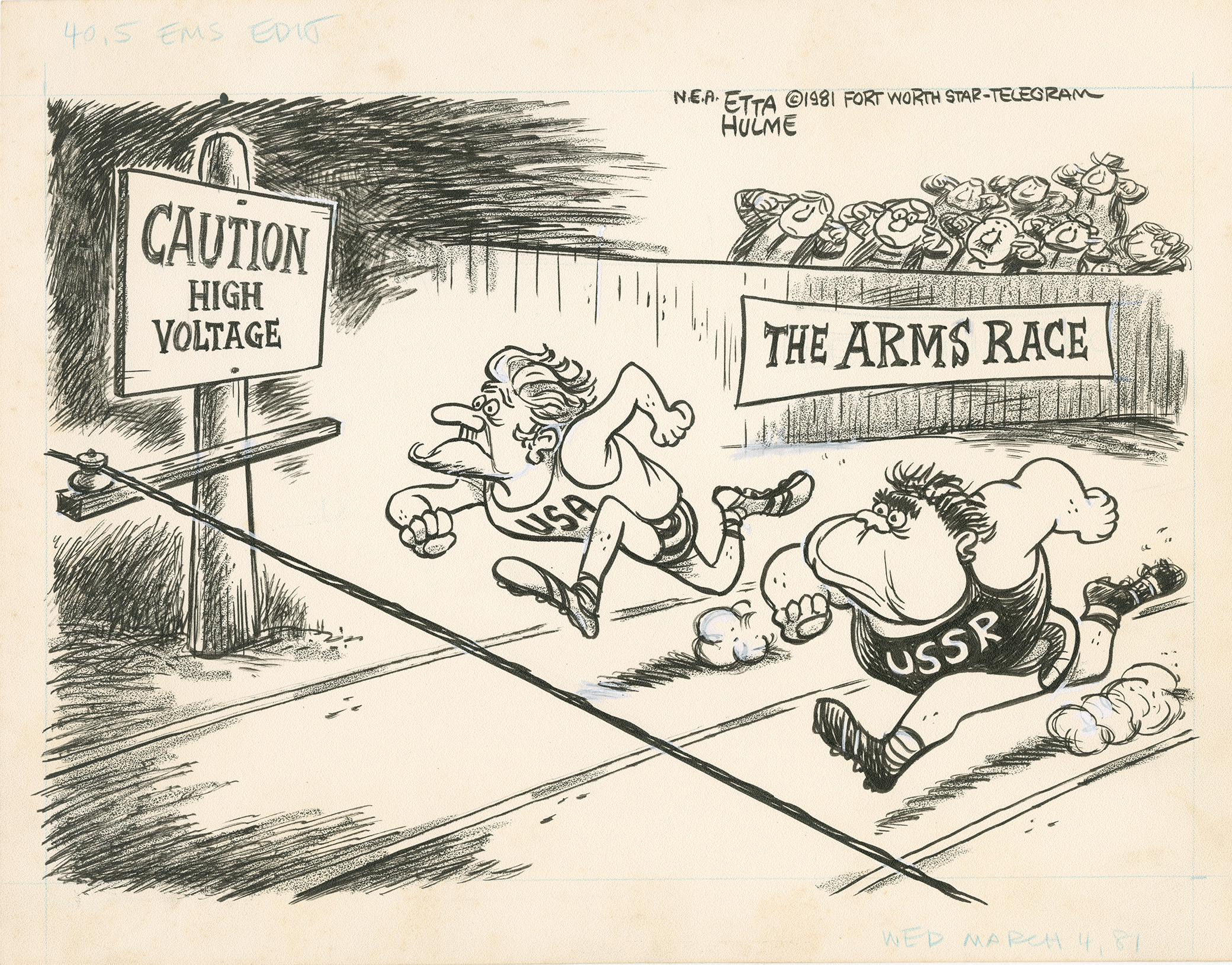
Lizzet Bautista, Eduardo Marin, Gregory Mejia, Javier Orozco, and Fiona Ramirez looked at the second Strategic Arms Limitation Talks, or, SALT II.
To understand SALT II, we must first understand SALT which began in January 1967, when President Lyndon B. Johnson announced that the Soviet Union had begun to construct a limited Anti-Ballistic Missile (ABM) defense system around Moscow. Johnson, therefore, called for strategic arms limitations talks (SALT), and in 1967, he and Soviet Premier Alexei Kosygin met at Glassboro State College in New Jersey. Nixon and Soviet General Secretary Leonid Brezhnev signed the ABM Treaty and interim SALT agreement on May 26, 1972, in Moscow.[38] SALT II was aimed at replacing the interim SALT I agreement with a comprehensive treaty providing broad limits on strategic offensive weapons. In June 1979, a week before the president was to sign the new treaty one that had taken seven years and three administrations to finalize Carter approved funding for the MX mobile missile to boost Senate chances of ratifying the treaty. Negotiations for the second round of SALT began in late 1972. Since SALT did not prevent each side from enlarging their forces through the deployment of Multiple Independently Targeted Re-Entry Vehicles (MIRVs) onto their ICBMs and SLBMs, SALT II initially focused on limiting, and then ultimately reducing, the number of MIRVs.
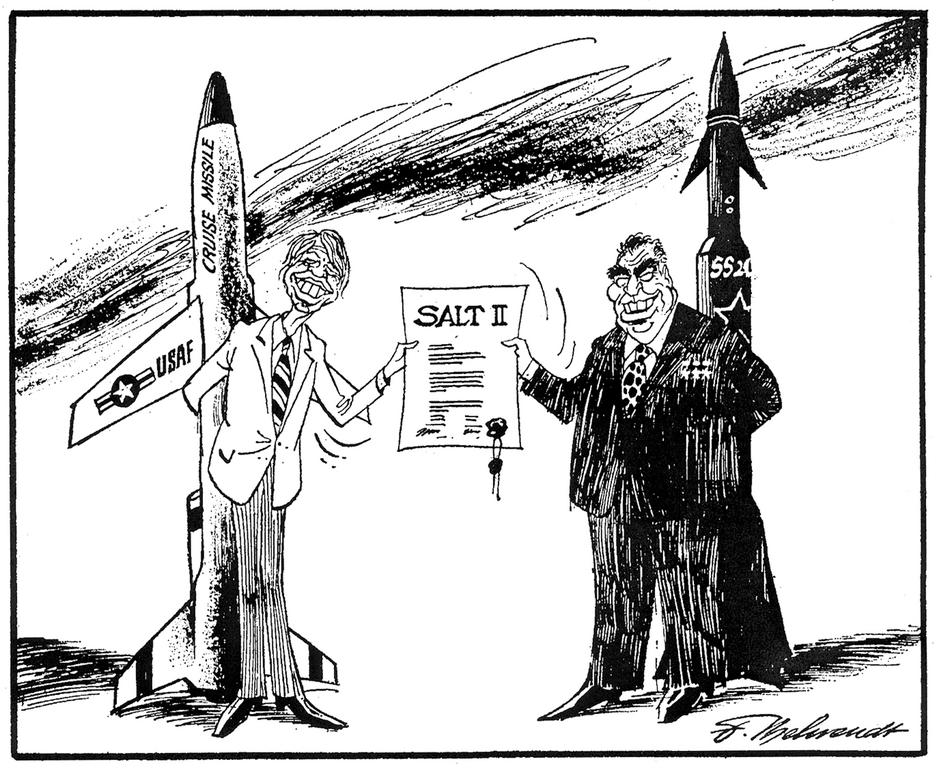
However, during the Cold War Reagan and his administration condemned Salt II, and later in the decade president would announce that the US would no longer comply with the limits in SALT II and would not continue its process of ratification, putting the treaty in limbo in Congress.[39] This worried some congressmen so much that two days after Reagan’s announcement they would hold a press briefing to state how they are against Reagan’s decision and how the decision was not helping the United States’ security. The press would ask questions about the reasons that Reagan gave on leaving SALT II such as Reagan believed that the Soviets had already broken the agreements. The congressmen did not believe in any of these allegations and believed that this was done by the people in Reagan’s administration who did not believe in arms control.[40]
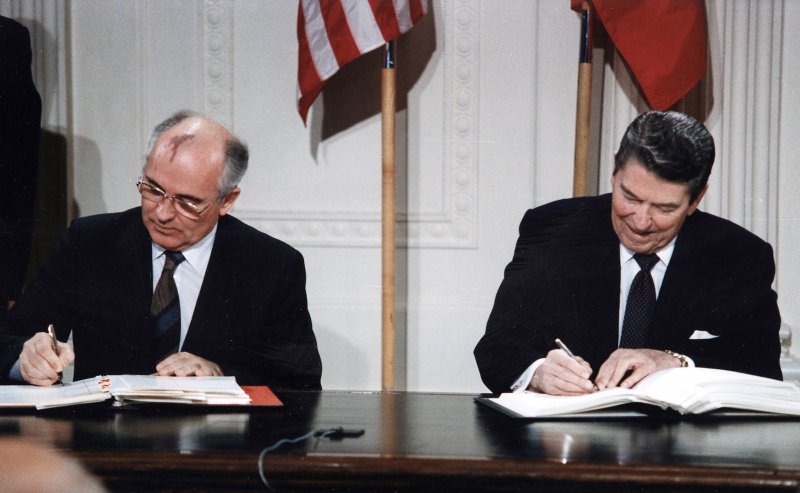
Interestingly enough, some would believe that it was not in the US’s best interest to be on SALT II but that of the Soviets Union. Washington Post journalist, Robert Kaiser, who discussed the competitive impulse he sees inherent in Soviet behavior. Kaiser believed that the Soviets have concluded that in a full-scale competition the United States would prevail thus the Soviets’ interest in constraining the U.S. weapons programs at a level where they have, until now, been able to compete with. Kaiser considers it unlikely that the U.S. could dissuade the Soviet leadership from its current level of defense spending. Kaiser feels that this concept will eventually be understood by the Soviets. In his opinion, the nature of strategic competition in the 1980s could play an instrumental role in urging Soviet acceptance of a broader concept of security. Kaiser is intrigued by the possibility that by the end of the 1980s the United States may have clear strategic superiority over the USSR.[41]
At the end of the day, Reagan did decide that what was best for U.S security was to follow through with SALT II despite his reluctance to do so.
1979
1979 was a terrible year for US intelligence, US security, US training operations, and the US State Department. In 1979 the US lost Afghanistan to the Russians, Iran to Islamic extremists, and Nicaragua to communists.
The Russian invasion, (failed) war, and departure from Afghanistan created a void that will be filled by the Taliban, who provided comfort and cover for such terrorists like Osama Bin Laden and resulted in both September 11th and the second-longest war in US history, which resulted in the Taliban once again seizing control following the US pullout in 2021. Afghanistan was Russia’s Vietnam, but with much dire international consequences to include the rise of staunch nationalists in Russia such as the former KGB operative Vladamir Putin, whose government and NGOs interfered in the US presidential elections of 2016 and 2020.
The US-backed dictator of Iran, Reza Shah Pahlavi, was toppled by a student-led revolution that ultimately handed the keys to the castle over to Muslim extremists such as the longtime-exiled Ayatollah Khomeini, who slowly turned Iran into a theocracy. But the US had built up Iran to be the fourth largest military in the world. Yet the Western world cut off Iran from obtaining US weapons and replacement parts once Iranian revolutionaries held 52 Americans hostage for 444 days. Iran went to war against Iraq. France continued to trade with Iran and eventually, most of Europe returned to the trading table, with the US standing on the sideline. But that allowed Iran to dabble in nuclear technology. Of course, so too did Iraq, at least until Israel blew up Iraq’s only unfinished nuclear reactor in 1981. Take my Middle East class for that story.
Finally, with the demise of the Somoza family’s control over Nicaragua and the rise of the Sandinistas (led by Daniel Ortega) in 1979, the Communist country imported Russian weapons from AK-47 rifles to MI-24 Hind attack helicopters. Some of those weapons poured across the border into Honduras then into El Salvador carried by Salvadorans who had launched a Communist guerrilla war against the brutal, US-backed Salvadoran government. The name of the Sandinistas was the FSLN (Sandinista National Liberation Front) and in El Salvador, the communist guerrillas were the FMLN (Farabundo Marti National Liberation Front). The Reagan administration sent the CIA and US military advisors to Honduras and into El Salvador. Ultimately, it was the end of the Cold War that ended the fighting. An election in 1990 ended the rule of Daniel Ortega and the FMLN laid down their weapons (so too did the Contras). But the irony of these Cold War military-political jockeying is that today in Nicaragua the FSLN is in power and Daniel Ortega is the country’s president. They had an election in November of 2021. Before the election Ortega had 7 opposition candidates arrested. Ortega won re-election. Whaddya’ know? And in El Salvador, the FMLN went legitimate to become the ruling political party in the first few decades of the 21st century. However, both Honduras and El Salvador are messed up politically and economically. In the latter, it seems that gangs more often rule than the government. But that’s a story for my intro to Latin American studies class.
1979 was a bad year for the US, the Middle East, and Central America and 1979 still affects the US, the Middle East, and Central America today. Nonetheless, Communism in El Salvador, Nicaragua, and Cuba seems to have been the focus of Reagan when he initially took office.[42]
Iran-Contra
My team and I were watching the Iran-Contra hearings when Oliver North was testifying. Some of us, more than others, were worried as to what North was going to say. What was he going to give up? Who was he going to give up? More than a few packed their “go bag” just in case we had to quickly depart from our immediate area. So, as we are huddled around the television I am opening a letter from my parents (mail was delivered to us from the US Embassy in Honduras via an address in Florida), and in it contained a Doonesbury cartoon. Garry Trudeau draws Doonesbury, an editorial cartoon he has been drawing since the Vietnam era. That particular cartoon focused on a team of intelligence officials, huddled around their television, somewhere in Central America, watching Oliver North testifying, hoping that North would not name names. Trudeau had no idea how close he got that one. BTW, I have been looking for that cartoon for ages! If anyone happens to stumble upon it, let me know.
Anyhow, an interesting interconnected web of felonious intrigue from Lt. Col. Oliver North to Israel (TOW missiles) to Iran to Hezballah (to free Terry Anderson eventually) and Iranian money through back channels to North to the Contras. All while the US supported Iraq with arms and intelligence during the Iran-Iraq war.
Kellie Miralda:
The Iran-Contra Affair was one major scandal in the Reagan administration in the United States in the 1980s. The affair arise from the Reagan administration’s foreign policy between two countries, Nicaragua and Iran which had two different problems and were dealt with in two different ways. It was brought about by two initiatives during the administration of President Ronald Reagan. The first agreement was with the Contras in Nicaragua and the second dealt with the arms deal with Iran.
Despite the fact that the scandal came to light in November 1986, it actually started seven years earlier in both countries. In Nicaragua, there were two dictators who ruled, Somoza Garcia and his son Anastasio, there was a lot of protest through their ruling which ended with the Sandinista overthrowing them and seizing power. With the new regime, many Nicaraguans didn’t agree to it and started a counter-revolution, which the administration decided to help and provided them with financial and material support. In contrast, Iran, which had a new ruler, Ayatollah Khomeini wanted to break all ties with the U.S. The Administration tried to bolster moderate elements within Iran, a policy that became more complicated when Iranian-backed Lebanese terrorist groups seized American hostages.[43]
A series of American hostage-takings in Lebanon conducted Iranian- backed Lebanese terrorist organization, Hezbollah and its affiliates begin in 1982 and was a key precursor to the arms deal.[44] Officials in the Reagan administration sold anti-tank missiles to Iran to let them release the hostages, and they used the money from the sales to fund US military support to the Contras. Congress also had passed the Boland amendment, limiting US assistance to the Contras in Nicaragua, but it soon expired. To which they made Boland amendment II, after signing it the law initiated a series of policy decisions designed specifically to circumvent the law that included selling weapons to Iran and raising funds for the contras through various private contributors.[45]
In 1986, the secret dealing of the Reagan administration in Central America and the Middle East came out to the public, when a plane crash carrying weapons to the Contras in Nicaragua, and the surviving crew made statements about the U.S involvement. There were three investigations, conducted by a presidentially appointed commission headed by former Texas U.S. senator John Tower, by Congress, and finally by a special federal prosecutor.[46] Reagan promptly raised the issue in a June speech, warning that unless a tough stand was taken, a “tidal wave” of “feet people” would be “swarming into our country”.[47] Although he denied his administration had any involvement in the scandal, it made the public mistrust him and question his actions.
The Iran Contra Affair is difficult to understand at times. It is hard to determine who told the truth, and who lied. He was the head of the United State government who had all the power and knew everything that went on. He lied to Congress, to the American people, and had his administration do the same for him. In the end, he was as much to blame for the scandal as anyone else.
1979 was a bad year because of the loss of 3 allies. 1983 was a bad year for the US Marines and by extension, the country when on October 23rd two truck bombs hit the Marine barracks killing 241 Marines. The largest single-day loss of Marines since World War II. US Marines were sent into Lebanon as part of a multinational peacekeeping force to quell the civil war between Christian and Muslim factions while the Palestine Liberation Organization withdrew from Lebanon. Marines were non-combatants. However . . .
Lebanon
Israel invaded Lebanon in 1981, ostensibly to clear out Palestinian Liberation Organization (PLO) locations firing from the border area into Israel. But Israeli forces went to the outskirts of Beirut, and there was a civil war to boot. This was not the Marines’ first trip to Lebanon. Eisenhower sent them in 1958. But 1982 was different. They were part of something larger and their mission was to keep everyone apart from everyone else while the PLO, Syrian forces, and others withdrew. Oh yea, and then the Lebanese President was assassinated. Israel invaded Lebanon in 1982 and besieged West Beirut for weeks until the PLO agreed to withdraw from Lebanon. And so, an international peacekeeping force was assembled and sent to Lebanon, including French and Italian forces.
1,400 US Marines came ashore in August of 1982 to take control and security of the international airport in Beirut as well as protection for US diplomatic corp around Beirut. Their mission was supposed to last 30 days. Remember the War Powers Act?
On April 18th, 1983, a terrorist truck-bombed the US Embassy in Beirut, killing 63.

On October 23rd, 1983, twin suicide truck bombers hit the US Marine barracks in Beirut killing 241 US Marines (and 58 French paratroopers). President Reagan pulled the remaining Marines out of Lebanon on Feb 26, 1984. Their 30-day mission became an 18-month deployment. In all, 265 Americans were killed, and 159 were wounded.
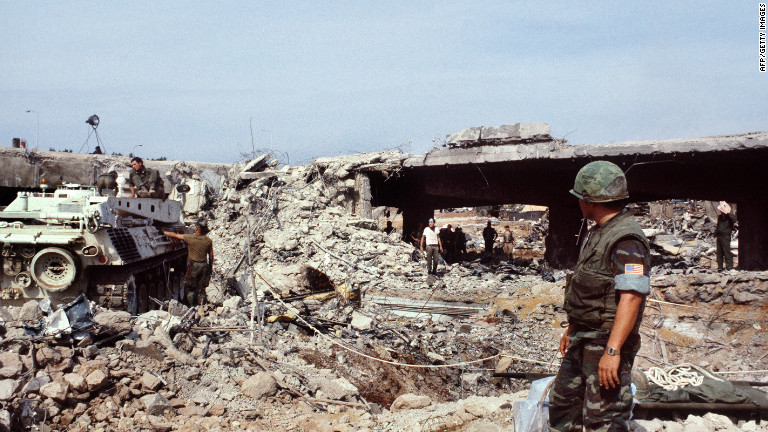
For a full history of the 1982-1984 US Marine presence in Lebanon, go here.
Russia/Cold War
While Carter backed up into the Cold War, the Cold War heated up during the Reagan years. Reagan envisioned himself as this stalwart against Communism and as he supported a new direction of US foreign policy. Called the National Security Decisions Directive 22 (NSDD-22) the uS was going to out-spend Russia. Cripple the “Evil Empire” economically. Make it so that Russia would not be able to keep up with the pace of US military spending. And boy, did Congress (led by Rep. Thomas “Tip” O’Neill, a Democrat from Massachusetts, who was Speaker of the House from 1977 to 1987) go on a spending spree.
Reagan’s first budget request included a 10% increase in military spending.[48] And although O’Neill initially rejected such a large increase, he did work with the President. Acknowledging the landslide 1980 election, the Speaker of the House said “We’re going to cooperate with the president. It’s America first and party second,” O’Neill said, just days after the Reagan landslide. “We’re going to give ‘em enough rope. They can use it either to herd cattle, or make a mistake. … They’ve got to deliver.”[49]
Well, Reagan did not get is 10% increase, but military spending did increase dramatically. “Between 1980 and 1985, the number of dollars devoted each year to defense more than doubled, from $142.6 billion to $286.8 billion. The Navy increased its force from 479 combat ships to 525, while the Army bought thousands of the new Abrams tanks and Bradley Fighting Vehicles. An Army attack helicopter called the Apache, a key weapon in both gulf wars, made its debut.”[50] As recent as 2021, the Ronald Reagan Presidential Foundation and Institute called for increased Pentagon spending to counter the threat from China.[51] Beating the same drum, even after the death of the President.
In the end, “The federal budget grew fat and swollen, dotting the Maryland and Northern Virginia suburbs with defense contractors and government consultants. Reagan didn’t drain the swamp in Washington: He made it the imperial capital it is today. Along the way, he raised taxes—seven times.”[52]
I would like to thank Lizzet Bautista, Eduardo Marin, Gregory Mejia, Javier Orozco, Fiona Ramirez, and Kellie Miralda for their interest in and dedication to US foreign policy in the 1980s. They all selected what aspects of 1980s foreign policy they were going to look at.
As with the other chapters, I have no doubt that this chapter contains inaccuracies therefore, please point them out to me so that I may make this chapter better. Also, I am looking for contributors so if you are interested in adding anything at all, please contact me at james.rossnazzal@hccs.edu.
- https://www.reaganlibrary.gov/archives/speech/address-citizens-western-europe-0 ↵
- https://www.smithsonianmag.com/history/surprising-story-american-girl-who-broke-through-iron-curtain-180969043/ ↵
- https://alphahistory.com/coldwar/letters-samantha-smith-yuri-andropov-1983/ (last accessed 13 Apr 2023) ↵
- Ibid ↵
- Correspondence from Anne Higgins, Special Assistant to the President and Director of Correspondence to Mr. and Mrs. Donald K. Jelks, June 1st, 1983. Ronald Reagan Presidential Library. Digital Library Collections. Presidential Correspondence. Casefile Number: 142046. ↵
- Ibid ↵
- Correspondence between Morton Matthew and Representative Nancy Johnson (CT), July 11th, 1983. Ronald Reagan Presidential Library. Presidential Correspondence. Casefile Number 154386 (Last accessed 13 Apr 2023). ↵
- Correspondence from Alvin Paul Drischler, Acting Assistant Secretary, Legislative and Intergovernmental Affairs to Representative Nancy Johnson to September 8th, 1983. Ronald Reagan Presidential Library. Presidential Correspondence. Casefile Number: 154386. (Last accessed 13 Apr 2023) ↵
- Correspondence from President Ronald Reagan to Mr. Dale Garcia of Santa Fe, NM. November 1, 1983. Ronald Reagan Presidential Library. Presidential Correspondence. Casefile Number: 183545 (Last accessed 1 Apr 2023). In the letter, Reagan referenced the September 1st, 1983 Soviet downing of a Korean civilian airliner (KAL 007), killing 269 passengers and crew, as evidence of the Soviets’ “contempt for human life.” ↵
- Correspondence to President Ronald Reagan from Disney Channel regarding the President’s participation on the show “Samantha Smith Goes to Washington ’84.” Ronald Reagan Presidential Library. Presidential Correspondence. Casefile Number: 154386. (Last accessed 3 May 2023) ↵
- Correspondence between Representative Nancy Johnson to Kenneth Duberstein, Assistant to the President for Legislative Affairs. July 15, 1983, regarding a letter to Rep Nancy Johnson from Morton Matthew. Ronald Reagan Presidential Library. Presidential Correspondence. Casefile Number: 154386. (Last accessed 3 May 2023) ↵
- https://www.reaganlibrary.gov/archives/speech/address-nation-united-states-policy-central-america ↵
- Notes by Julia Watterson ↵
- Walter C. Ladwig III. "Influencing Clients in Counterinsurgency: U.S. Involvement in El Salvador’s Civil War, 1979–92." International Security 41, no. 1 (2016): 109, muse.jhu.edu/article/628477. (Last accessed February 8, 2022). ↵
- ohn Beverley. “El Salvador,” Social Text, no. 5 (1982): JS TOR, 42, https://doi.org/10.2307/466334. (Last accessed February 14, 2022). ↵
- Ladwig. "Influencing Clients in Counterinsurgency: U.S. Involvement in El Salvador’s Civil War, 1979–92," 107. ↵
- Beverley. “El Salvador,” 70. ↵
- Ibid., 70. ↵
- What follows is from my student Kathryn Page. ↵
- Sorensen, Grace, and Noah Schramm. “The Massacre of El Mozote: 36 Years of Struggles for Truth and Justice.” Center for Human Rights, University of Washington. (January 3, 2018.) <https://jsis.washington.edu/humanrights/2018/01/03/mozote-36-years/.> [Accessed January 26th, 2022] ↵
- Scott, Douglas D. “Firearms Identification in Support of Identifying a Mass Execution at El Mozote, El Salvador.” Historical Archaeology 35, no. 1 (2001): 79–86. <http://www.jstor.org/stable/25616895.> [Accessed January 26, 2022] ↵
- Scott, “Firearms Identification.” 80. ↵
- Estrada, Ruth Elizabeth Velásquez. “Grassroots Peacemaking: The Paradox of Reconciliation in El Salvador.” Social Justice 41, no. 3 (137) (2015): 69–86. <http://www.jstor.org/stable/24361633.> [Accessed January 26th, 2022] ↵
- Scott, “Firearms Identification.” 80. ↵
- Bonner, Raymond. “Time for a US Apology to El Salvador.” The Nation, December 12, 2016. <https://www.thenation.com/article/archive/time-for-a-us-apology-to-el-salvador/.> [Accessed January 26th, 2022] ↵
- Bonner, “America's Role in El Salvador's Deterioration.” ↵
- Gressier, “U.S. Government Hid Presence of U.S. Advisor in El Mozote Massacre, Expert Says.” ↵
- Rauda, Nelson, and John Washington. “Perspective | The U.S. Role in the El Mozote Massacre Echoes in Today's Immigration.” WP Company, The Washington Post. (May 12, 2021.) <https://www.washingtonpost.com/outlook/2021/05/13/us-role-el-mozote-massacre-still-echoes-immigration-today/.> [Accessed January 26th, 2022] ↵
- Rauda, Washington, “Perspective.” ↵
- Bonner, “Time for a US Apology.” ↵
- By Julia Watterson ↵
- Gressier, “U.S. Government Hid Presence of U.S. Advisor in El Mozote Massacre, Expert Says.” ↵
- Bonner, “America's Role in El Salvador's Deterioration.” ↵
- Stephen F. Rosenthal. “US Policy in El Salvador.” Harvard International Review 12, no. 2 (1990): 38, http://www.jstor.org/stable/42760172. (Last Accessed February 12, 2022). ↵
- Bonner, “America's Role in El Salvador's Deterioration.” ↵
- Rosenthal. “US Policy in El Salvador,” 38. ↵
- By Katheryn Page ↵
- J.P, and G.D. 1979. "The Soviets and SALT." Arms Control Today 8-9. http://www.jstor.org/stable/23622693. ↵
- Downey, Congressman Thomas. 1982. "The Reagan Freeze on Salt." Arms Control Today 1-3,9. Accessed September 23, 2021. http://www.jstor.org/stable/23623067. ↵
- Warnke, Paul C., Gerard C. Smith, Robert S. McNamara, and Spurgeon M. Keeny. 1986. "The Folly of Scrapping SALT: Arms Control Experts Believe Reagan Decision Will Undermine U.S. Security." Arms Control Today 3-7. Accessed September 25, 2021. http://www.jstor.org/stable/23623401. ↵
- J.P, and G.D. 1979. "The Soviets and SALT." Arms Control Today 8-9. http://www.jstor.org/stable/23622693. ↵
- https://history.state.gov/departmenthistory/short-history/reaganforeignpolicy ↵
- “The Iran Contra Affair.” Understanding the Iran-Contra affairs - the Iran-Contra Affairs, 2012. https://www.brown.edu/Research/Understanding_the_Iran_Contra_Affair/iran-contra-affairs.php. ↵
- Alex, Douville. “THE IRAN-CONTRA AFFAIR.” Edited by Richard Weitz. CASE STUDIES WORKING GROUP REPORT. Strategic Studies Institute, US Army War College, 2012. http://www.jstor.org/stable/resrep11953.7. Pg.15 ↵
- HCC College History Department. American Perspectives: Readings in American History Vol. 2. Available from Yuzu Reader, (7th Edition). McGraw-Hill Learning Solutions, [2019]. Pg.581 ↵
- Larry, Sabato. “The Iran-Contra Affair – 1986-1987.” The Washington Post. WP Company, 1998. https://www.washingtonpost.com/wp-srv/politics/special/clinton/frenzy/ginsburg.htm. ↵
- Robert, Parry, and Kornbluh Peter. “Iran-Contra’s Untold Story.” Foreign Policy, no. 72 (1988): 3–30. https://doi.org/10.2307/1148818. Pg.5 ↵
- https://www.nytimes.com/1983/03/17/us/reagan-and-o-neill-each-one-needs-the-other.html ↵
- https://www.politico.com/magazine/story/2016/11/donald-trump-democrats-tip-o-neill-214467/ ↵
- https://www.baltimoresun.com/news/bal-te.pentagon08jun08-story.html ↵
- https://www.reaganfoundation.org/reagan-institute/publications/don-t-skimp-on-the-defense-budget/ ↵
- https://www.politico.com/magazine/story/2016/11/donald-trump-democrats-tip-o-neill-214467/ ↵


